Fomalhaut, Alpha Piscis Austrini (α PsA), is a white main sequence star located in the constellation Piscis Austrinus, the Southern Fish. With an apparent magnitude of 1.16, it is the brightest star in Piscis Austrinus and the 18th brightest star in the sky. It lies at a distance of 25.13 light-years from Earth.
Fomalhaut has two of the widest known companions discovered to date and is one of brightest stars with a candidate planet. The planet, Fomalhaut b, is known by the proper name Dagon.
The star is also known for its vast circumstellar debris ring, which has earned it the nickname “the Eye of Sauron,” a reference to J.R.R. Tolkien’s mythos. In 2023, Fomalhaut’s dusty debris disk was imaged by NASA and ESA’s James Webb Space Telescope (JWST).
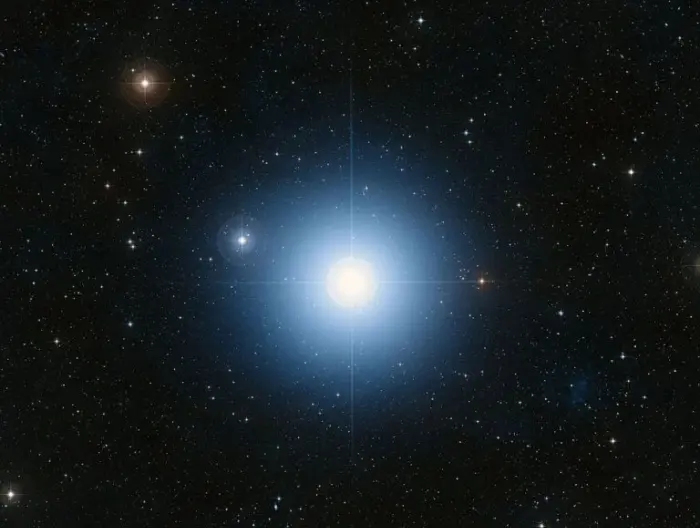
This image shows Fomalhaut, the star around which the newly discovered planet orbits. Fomalhaut is much hotter than our Sun, 15 times as bright, and lies 25 light-years from Earth. It is blazing through hydrogen at such a furious rate that it will burn out in only one billion years, 10% the lifespan of our star. The field of view is 2.7 x 2.9 degrees. Image: NASA, ESA, and the Digitized Sky Survey 2. Acknowledgment: Davide De Martin (ESA/Hubble)
Star system
Alpha Piscis Austrini is a triple star system consisting of Fomalhaut, a bluish-white main sequence star, TW Piscis Austrini (commonly referred to as Fomalhaut B), an orange main sequence star, and LP 876-10 (Fomalhaut C), a red dwarf. The three components appear several degrees apart in the sky. Fomalhaut B and C were only confirmed as companions in 2012 and 2013.
Fomalhaut B is at least 54,000 astronomical units away from the primary star and takes at least 7.6 million years to complete an orbit, while Fomalhaut C has an estimated orbital period of 22 million years.
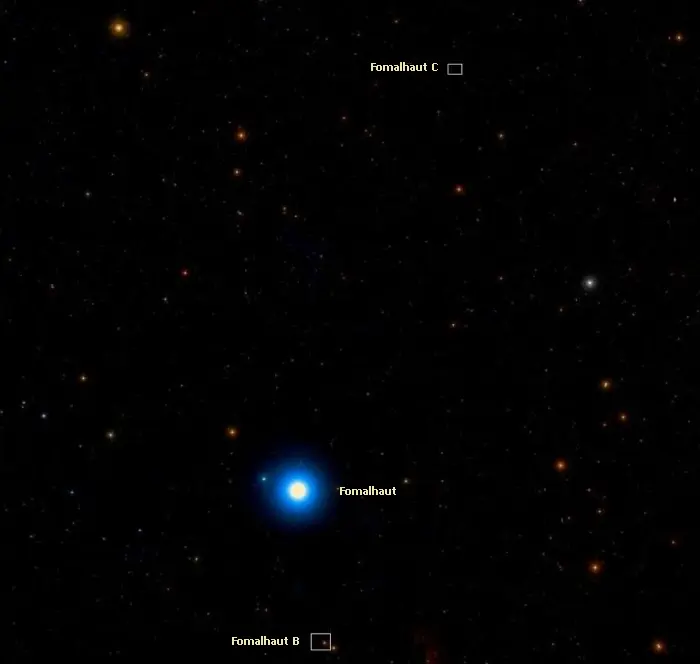
Fomalhaut A, Fomalhaut B and Fomalhaut C, image: Wikisky
Fomalhaut (Alpha Piscis Austrini A)
Fomalhaut has the stellar classification A3 V, indicating a hydrogen-fusing dwarf, appearing white or blue-white in colour. The star has almost twice the Sun’s mass (1.91 M☉) and radius (1.842 R☉). With an estimated surface temperature of 8,590 K, it shines with 16.63 solar luminosities.
A 2012 study of the star’s age and binarity gave an estimated age of 440 million years. The same study unequivocally confirmed that TW Piscis Austrini was a physical companion to Fomalhaut, with a similar velocity and at a separation of 0.280 parsecs from the primary.
Even though Fomalhaut is much younger than the Sun (4.5 billion years), as a more massive star, it has evolved faster. It will exhaust the supply of hydrogen in its core within a billion years and evolve into a red giant before expelling its outer layers to form a planetary nebula and gradually fading away as a white dwarf.
Fomalhaut has a significantly lower metallicity than the Sun. Different studies have given different values, in the range from 78% to 93% of the Sun’s iron abundance. In 2008, spectroscopic measurements yielded a value of 46% of the Sun’s metallicity.
Fomalhaut is a Vega-like star, showing excess emissions in infrared wavelengths, which indicates the presence of a circumstellar disk. The star is in fact surrounded by several disks of debris. The one closest to the star lies at a distance of 0.1 astronomical units, while the middle disk is between 0.4 and 1 astronomical units from the star. The outermost disk, sometimes called “Fomalhaut’s Kuiper belt,” lies at a radial distance of 133 astronomical units. The dust in the outer disk spreads in a belt some 25 astronomical units wide.
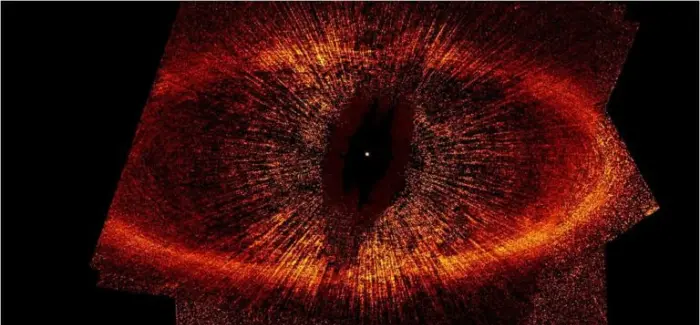
Fomalhaut debris ring, image: NASA/Hubble
The star’s debris disk emits a significant amount of infrared radiation and is thought to be protoplanetary. It lies in Fomalhaut’s equatorial plane.
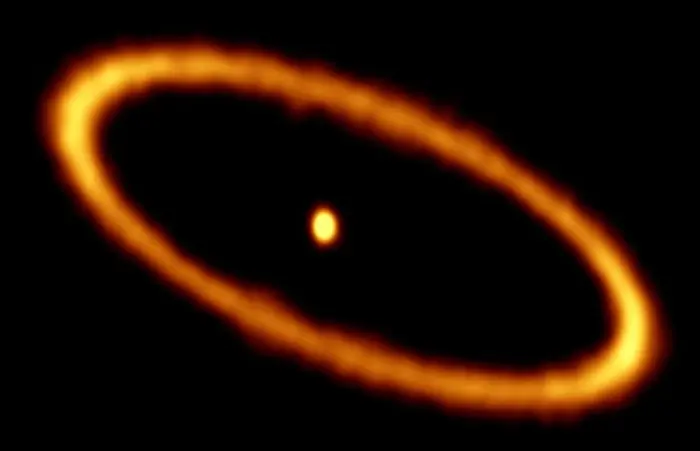
This image from the Atacama Large Millimeter/submillimeter Array (ALMA) shows Fomalhaut (centre) encircled by a ring of dusty debris — this is the first time this scene has been captured at such high resolution and sensitivity at millimetre wavelengths. Fomalhaut’s disc comprises a mix of cosmic dust and gas from comets in the Fomalhaut system (exocomets), released as the exocomets graze past and smash into one another. This turbulent environment resembles an early period in our own Solar System known as the Late Heavy Bombardment, which occurred approximately four billions years ago. This era saw huge numbers of rocky objects hurtle into the inner Solar System and collide with the young terrestrial planets, including Earth, where they formed a myriad of impact craters — many of which remain visible today on the surfaces of planets such as Mercury and Mars. Fomalhaut is known to be surrounded by several discs of debris — the one visible in this ALMA image is the outermost one. The ring is approximately 20 billion kilometers from the central star and about 2 billion kilometers wide. Such a relative narrow, eccentric disc can only be produced by the gravitational influence of planets in the system, like Jupiter’s gravitational influence on our asteroid belt. In 2008 the NASA/ESA Hubble Space Telescope discovered the famous exoplanet Fomalhaut b orbiting within this belt, but the planet is not visible in this ALMA image. Image: ALMA (ESO/NAOJ/NRAO)/L. Matrà/M. A. MacGregor, 2017
Planet
The discovery of Fomalhaut b, an extrasolar planet orbiting Fomalhaut, was announced on November 13, 2008. The planet was imaged by the Hubble Space Telescope. It orbits the star inside the outermost debris ring. It was the first extrasolar planet captured in visible light.
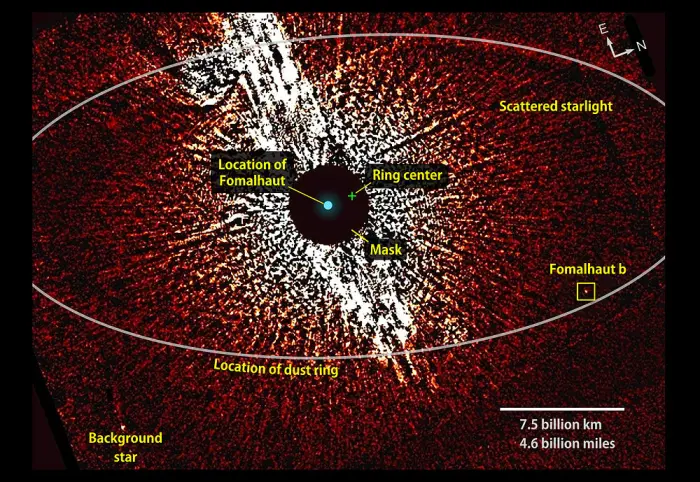
This labeled visible-light image from the Hubble Space Telescope combines two 2006 observations and shows the Fomalhaut system. It includes the locations of its dust ring an Fomalhaut b, an exoplanet that orbits the star. Imagecredit: NASA/ESA/T. Curie/U. Toronto
Fomalhaut b does not appear in images taken in infrared wavelengths and in spite of being extensively studied, its nature is still uncertain. It has been called a “zombie” planet because not long after its discovery, its existence was dismissed as dust and gas, and then confirmed again in 2012.
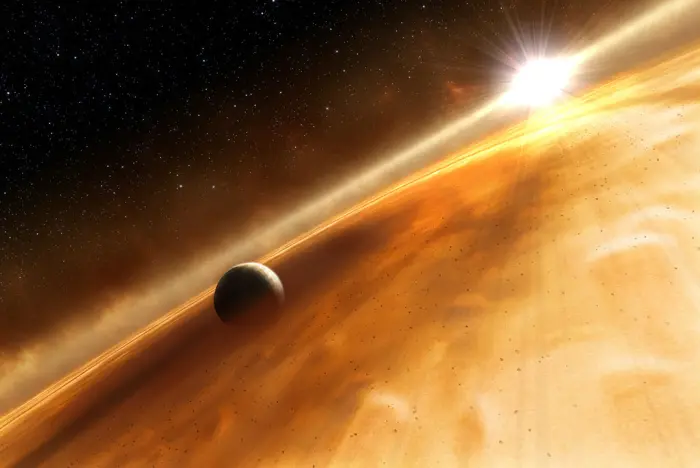
This illustration shows the newly discovered planet, Fomalhaut b, orbiting its sun, Fomalhaut. A structure comprised mostly of brown and gold colors surrounds Fomalhaut b. This structure is a Saturn-like ring that astronomers say may encircle the planet. Fomalhaut also is surrounded by a ring of material. The edge of this vast disk is shown in the background as the curving cloud-like feature that appears to intersect the star. Fomalhaut b lies 1.8 billion miles inside the disk’s inner edge. The planet completes an orbit around Fomalhaut every 872 years. Image credit: ESA, NASA, and L. Calcada (ESO for STScI)
The planet’s existence was proposed two years prior to the announcement, based on the eccentricity and sharpness of the edge of the debris ring. Based on observations with the Hubble Space Telescope’s Advanced Camera for Surveys, researchers suggested that the suspected planet had a mass between those of Neptune and Saturn and a semi-major axis of about 119 astronomical units.
The Hubble images released in 2008 revealed a planet close to Jupiter in mass (between 0.2 and 2 Jovian masses) and were consistent with the earlier predictions of the planet orbiting at a distance of 119 astronomical units, taking 872 years to complete an orbit around Fomalhaut.
Fomalhaut b is believed to have a vast planetary ring system and may show us what Jupiter’s rings looked like before the debris consolidated into the four Galilean moons, and what Jupiter and Saturn looked like when the solar system was only a million years old.
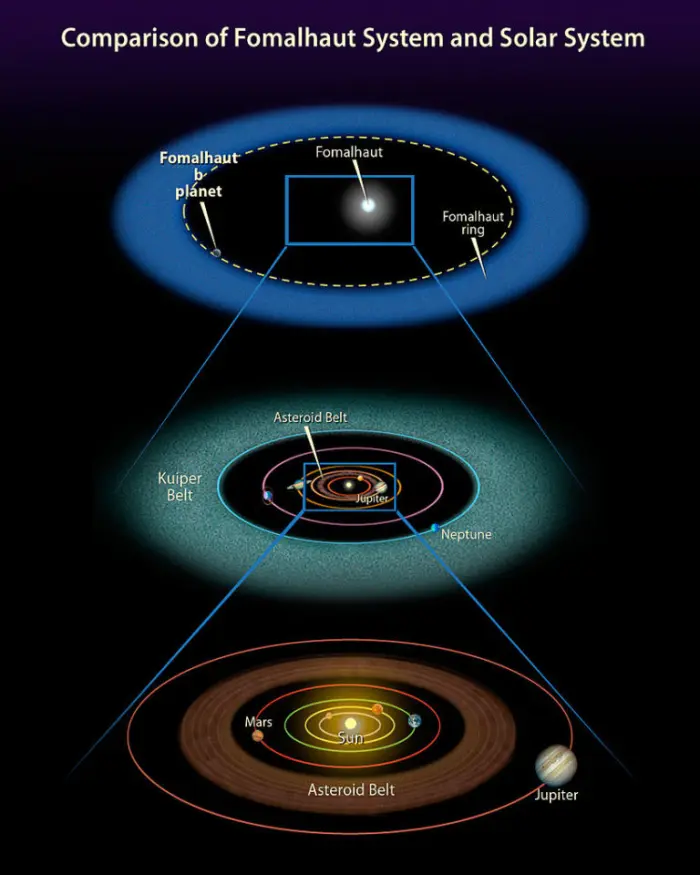
Comparison of Fomalhaut system and the solar system, image credit: NASA, ESA, and A. Feild (STScI)
Follow-up modelling of the way Fomalhaut’s debris disk is gravitationally perturbed by a single planet indicated that the planet’s orbit may not be apsidally aligned with the debris disk, which would mean that it is possible that there are other planets shaping the structure of the dust disk.
An M-band survey of Fomalhaut carried out in December 2006 and published in 2009 ruled out the presence of planets with more than 2 Jupiter masses from 13 to 40 astronomical units from the star and objects with more than 13 Jupiter masses (brown dwarfs) from 8 to 40 astronomical units.
In 2012, observations with the Spitzer Space Telescope indicated that Fomalhaut b was not a planet, but a transient or semi-transient dust cloud. They ruled out the possibility that flux from a giant planet was responsible for the flux seen in the visible light images.

The Fomalhaut system harbors a large ring of rocky debris that is analogous to our Kuiper belt. Inside this ring, the planet Fomalhaut b is on a trajectory that will cause it to pass straight through the ring. The nature of the planet remains mysterious, with the leading theory being the planet is enveloped in a sphere of dust. The footage uses 5 images taken over 7 years using the Hubble Space Telescope. The ring is so large we don’t have enough coverage of the ring to animate it. Rather, it is a composite image that combines all the data on the ring. Image credit: Jason Wang (Caltech)/Paul Kalas (UC Berkeley) (CC BY 4.0)
However, two other independent studies published in 2012 and 2013 confirmed the existence of Fomalhaut b. They, however, could not confirm that it was a whole planet. The first study indicated that it was enveloped in debris which was likely associated with a massive body, ruling out the possibility that it is a dust cloud. The second study considered two possibilities – a large debris disk around an unseen planet and the result of a collision of two Kuiper-belt-like objects with radii of about 50 km – and confirmed that Fomalhaut b is a real object orbiting Fomalhaut, but the object’s nature was uncertain.
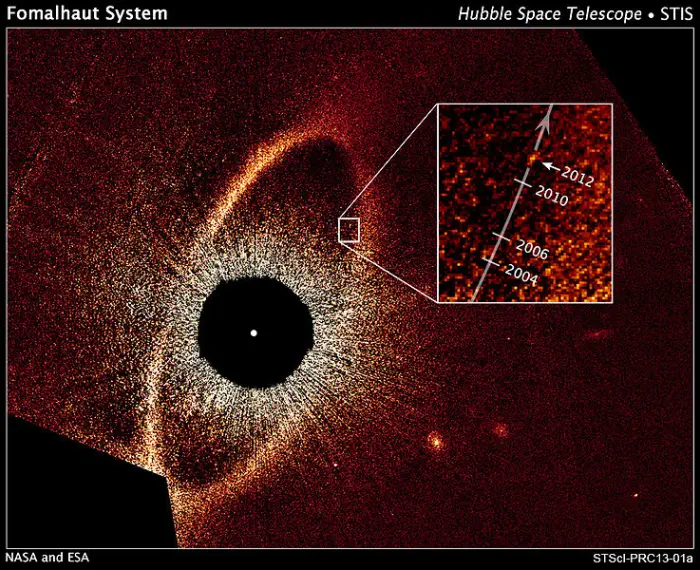
This false-color composite image, taken with the Hubble Space Telescope, reveals the orbital motion of the planet Fomalhaut b. Based on these observations, astronomers calculated that the planet is in a 2,000-year-long, highly elliptical orbit. The planet will appear to cross a vast belt of debris around the star roughly 20 years from now. If the planet’s orbit lies in the same plane with the belt, icy and rocky debris in the belt could crash into the planet’s atmosphere and produce various phenomena. The black circle at the center of the image blocks out the light from the bright star, allowing reflected light from the belt and planet to be photographed. The Hubble images were taken with the Space Telescope Imaging Spectrograph in 2010 and 2012. Credit: NASA, ESA, and P. Kalas (University of California, Berkeley and SETI Institute)
In 2012, far-infrared images taken by the Herschel Space Observatory revealed large amounts of fluffy micrometer-sized dust in Fomalhaut’s outer debris belt, indicating constant collisions of planetesimals, with a collision rate of about 2,000 kilometre-sized comets per day. The dust grains are believed to be fluffy aggregates, pointing to a cometary origin.
Observations of Fomalhaut’s debris ring with the Atacama Large Millimeter Array (ALMA) led to the idea that two shepherd planets were responsible for the ring’s morphology, with neither having an orbital radius proposed for the planet discovered by the Hubble Space Telescope.
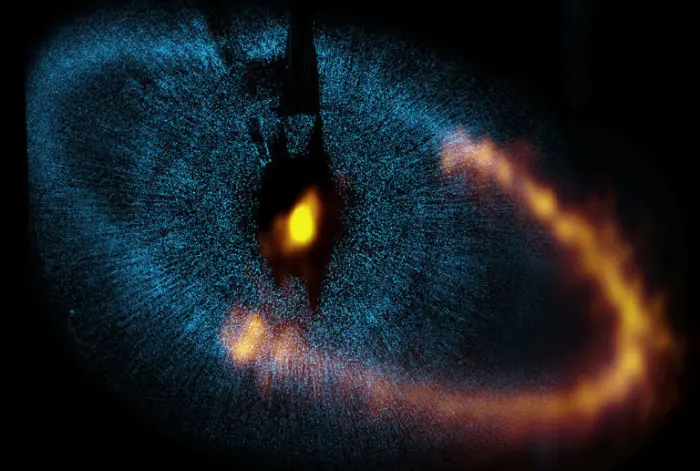
This view shows a new picture of the dust ring around the bright star Fomalhaut from the Atacama Large Millimeter/submillimeter Array (ALMA). The underlying blue picture shows an earlier picture obtained by the NASA/ESA Hubble Space Telescope. The new ALMA image has given astronomers a major breakthrough in understanding a nearby planetary system and provided valuable clues about how such systems form and evolve. Note that ALMA has so far only observed a part of the ring. Image credit: MA (ESO/NAOJ/NRAO). Visible light image: the NASA/ESA Hubble Space Telescope; Acknowledgement: A.C. Boley (University of Florida, Sagan Fellow), M.J. Payne, E.B. Ford, M. Shabran (University of Florida), S. Corder (North American ALMA Science Center, National Radio Astronomy Observatory), and W. Dent (ALMA, Chile), P. Kalas, J. Graham, E. Chiang, E. Kite (University of California, Berkeley), M. Clampin (NASA Goddard Space Flight Center), M. Fitzgerald (Lawrence Livermore National Laboratory), and K. Stapelfeldt and J. Krist (NASA Jet Propulsion Laboratory), 2012
In 2013, narrowband observations with the Very Large Telescope/NaCo suggested that any additional planets from 4 to 10 astronomical units from the star would have to have under 20 Jupiter masses. The observations ruled out the existence of any companion with more than 30 Jupiter masses from 2.5 astronomical units outward.
Fomalhaut b was given the name Dagon as part of a NameExoWorlds campaign. The International Astronomical Union (IAU) announced the elected name in December 2015. The planet is named after the ancient Mesopotamian and Canaanite deity Dagon, associated with fertility and often depicted as a half-man, half-fish.
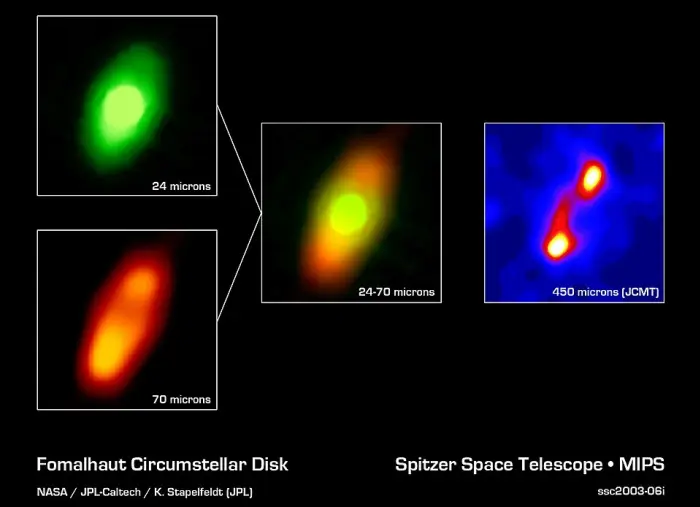
Twenty years ago, the Infrared Astronomical Satellite, the first orbiting infrared telescope, detected much more infrared radiation coming from Fomalhaut than was expected for a normal star of this type. The dust is presumed to be debris left over from the formation of a planetary system. However, the satellite did not have adequate spatial resolution to image the dust directly. Subsequent measurements with sub-millimeter radio telescopes suggested that Fomalhaut is surrounded by a huge dust ring 370 astronomical units (an astronomical unit is the average distance between the Sun and Earth), or 34 billion miles (56 billion kilometers) in diameter. This corresponds to a size of nearly five times larger than our own solar system. Moreover, the sub-millimeter observations (far right image) revealed that the ring was inclined 20 degrees from an edge-on view. The new images obtained with the multiband imaging photometer onboard Spitzer confirm this general picture, while revealing important new details of Fomalhaut’s circumstellar dust. The 70-micron data (red) clearly shows an asymmetry in the dust distribution, with the southern lobe one-third brighter than the northern. Such an unbalanced structure could be produced by a collision between moderate-sized asteroids in the recent past (releasing a localized cloud of dust) or by the steering effects of ring particles by the gravitational influence of an unseen planet. Image credit: NASA/JPL-Caltech/K. Stapelfeldt (JPL), James Clerk Maxwell Telescope
Fomalhaut B
The star Fomalhaut B, also designated TW Piscis Austrini, is located 0.91 light-years, or 0.28 parsecs from the primary component. Both its velocity and estimated age (400 ± 70 million years) indicate that the two stars are physically related.
Fomalhaut B has an estimated mass of 0.725 solar masses and a radius 63% that of the Sun. Its estimated surface temperature is 4,711 K and its luminosity only 0.19 L☉.
Fomalhaut B is classified as a BY Draconis variable, a star exhibiting variations in luminosity due to the effects of rotation and starspots. It is a flare star, showing sudden dramatic increases in brightness for very short periods (minutes). While it is considerably smaller and less massive than the Sun, TW PsA is significantly larger than most flare stars. The star’s brightness varies only slightly, from magnitude 6.44 to 6.49, over a period of 10.3 days.
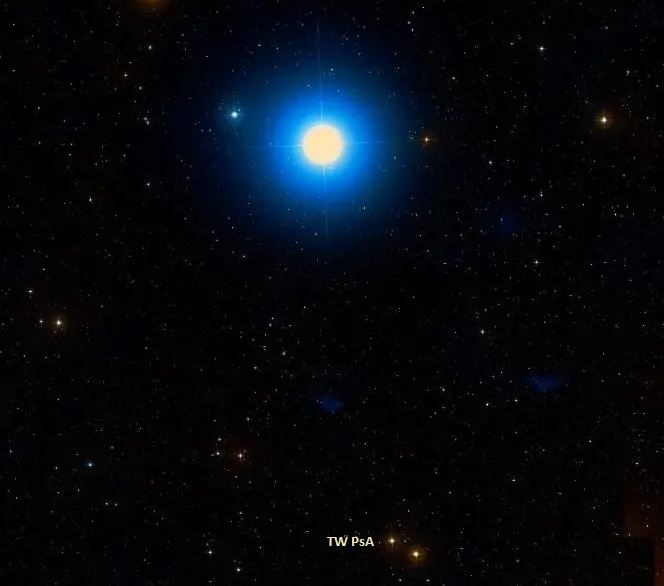
Fomalhaut and Fomalhaut B (TW Piscis Austrini), image: Wikisky
In 2018, observations with the Transiting Exoplanet Survey Satellite (TESS) revealed that Fomalhaut B may also host a planet, one with 92% of the Earth’s radius, but the evidence for the planet’s existence is weak and will not be confirmed until the next survey. The proposed planet lies about 0.082 astronomical units from the star and completes an orbit every 10.05 days.
Fomalhaut C
Fomalhaut C, also designated LP 876-10, is located in the neighbouring constellation Aquarius, about 5.7 degrees (about 11 full Moons) from the primary star. This makes Alpha PsA the widest star system ever discovered. Fomalhaut C lies about halfway between Fomalhaut and the Helix Nebula, 2.5 light years from the primary component and 3.2 light years from TW Piscis Austrini.
The star is a red dwarf of the spectral type M4V. It has 0.18 solar masses and (barely) shines with 0.0046 solar luminosities. It has an apparent magnitude of 12.624. Its estimated orbital period is 22 million years. Taking the system’s age into account, this means that Fomalhaut C has only completed an orbit around the primary star 22 times.
Fomalhaut C was confirmed to be a member of the Alpha Piscis Austrini system in October 2013, when Dr Eric Mamajek of the University of Rochester announced that the star’s velocity, distance and colour-magnitude position indicated that it was a member of the Fomalhaut system.
In 2013, infrared observations with the Herschel Space Observatory revealed a cold debris disk around the star. The disk has an estimated temperature of only 24 K and orbits at a distance between 10 and 40 astronomical units from the star. Like the disk around Fomalhaut A, it is believed to host many comets.
James Webb Space Telescope image
In 2023, astronomers used the James Webb Space Telescope (JWST) to capture the debris disk surrounding Fomalhaut. The data obtained with Webb revealed a more complex dust structure than previously thought and will help scientists study the first asteroid belt detected outside the solar system.
The Webb image revealed not only the outer ring but also an intermediate belt demarcated by an inner gap at 78 astronomical units and misaligned with the outer belt, as well as a large dust cloud in the outer ring. The data captured with Webb indicates that Fomalhaut is the site of a complex planetary system.
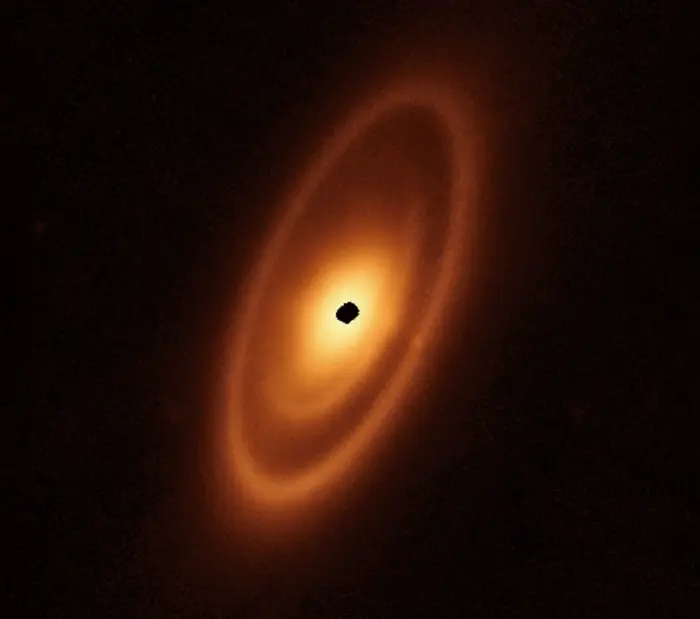
This image of the dusty debris disc surrounding the young star Fomalhaut is from Webb’s Mid-Infrared Instrument (MIRI). It reveals three nested belts extending out to 23 billion kilometres from the star. The inner belts — which had never been seen before — were revealed by Webb for the first time.The NASA/ESA Hubble Space Telescope and ESA’s Herschel Space Observatory, as well as the Atacama Large Millimeter/submillimeter Array (ALMA), have previously taken sharp images of the outermost belt. However, none of them found any structure interior to it. These belts are most likely shaped by the gravitational forces produced by unseen planets. Image credit: NASA, ESA, CSA, A. Pagan (STScI), A. Gáspár (University of Arizona)
The images were taken with Webb’s Mid-Infrared Instrument (MIRI). They revealed three nested belts stretching out to 23 billion kilometres from Fomalhaut. This is 150 times the distance from Earth to the Sun. The outermost belt – which is about twice the scale of our Kuiper’s Belt – was previously captured by the Hubble Space Telescope, the Herschel Space Observatory, and the Atacama Large Millimeter/submillimeter Array (ALMA), but the two inner belts had not been seen before. Webb was the first to resolve them in infrared light. The space telescope was able to show the thermal glow from dust in the warmer inner belts.
The dusty structures are composed of debris produced in collisions of larger bodies (analogous to comets and asteroids). They are believed to have been sculpted by gravitational forces of unseen planets orbiting the star, much like the inner edge of the Kuiper Belt is shaped by Neptune. The patterns in the rings will help astronomers understand what a planetary system around Fomalhaut may look like.
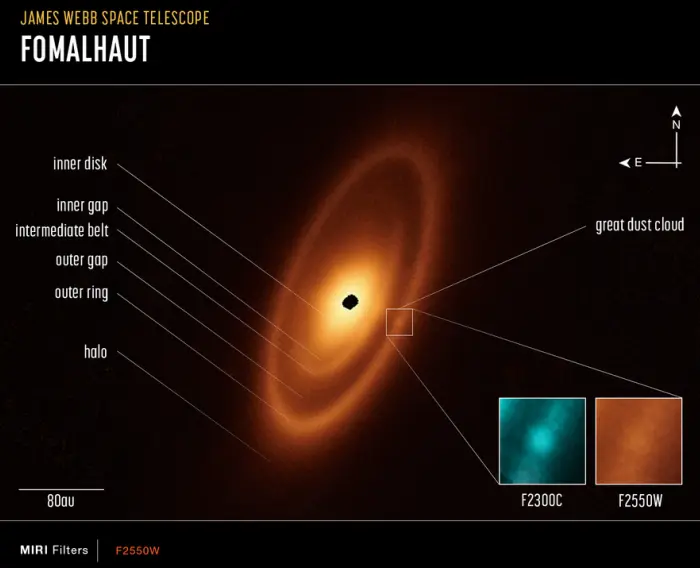
This image of the Fomalhaut system, captured by Webb’s Mid-Infrared Instrument (MIRI), shows compass arrows, scale bar, and color key for reference. Labels indicate the various structures. At right, a great dust cloud is highlighted and pullouts show it in two infrared wavelengths: 23 and 25.5 microns. The north and east compass arrows show the orientation of the image on the sky. Note that the relationship between north and east on the sky (as seen from below) is flipped relative to direction arrows on a map of the ground (as seen from above). The scale bar is labeled in astronomical units, which is the average distance between the Earth and the Sun, or 93 million miles. The outer ring is about 240 astronomical units in diameter. This image shows invisible mid-infrared wavelengths of light that have been translated into visible-light colors. The color key and labels show which MIRI filters were used when collecting the light. Image credit: NASA, ESA, CSA IMAGE PROCESSING: András Gáspár (University of Arizona), Alyssa Pagan (STScI); science: András Gáspár (University of Arizona)
The James Webb telescope also captured what the astronomers call “the great dust cloud,” which may indicate that there was a collision between two protoplanetary bodies in the outermost ring.
The study of Fomalhaut’s debris disks, led by András Gáspár of the University of Arizona in Tucson, was published in the journal Nature Astronomy.
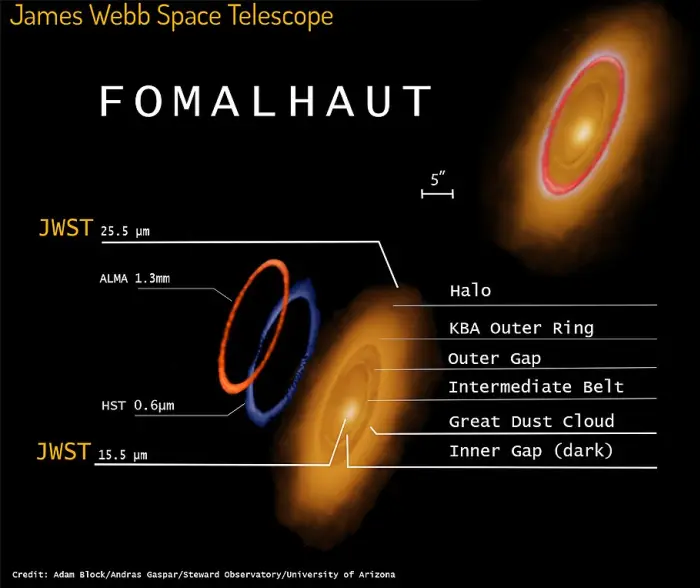
This image shows the discovery features in the debris disk of Fomalhaut from the James Webb Space Telescope (JWST) as well as overlays of Hubble Space Telescope (HST) data and the Atacama Large Millimeter/submillimeter Array (ALMA). The corresponding wavelengths of these observations are indicated as well as annotated features. Image credit: Wikimedia Commons/Ngc1535 (CC BY-SA 4.0)
Facts
Alpha Piscis Austrini is the first star system to have an extrasolar planet candidate imaged at visible wavelengths. The image was released in November 2008. Fomalhaut is also the third brightest star (after the Sun and Pollux) with a confirmed planet in its orbit.

This labeled visible-light image from the Hubble Space Telescope combines two 2006 observations and shows the Fomalhaut system. It includes the locations of its dust ring an Fomalhaut b, an exoplanet that orbits the star. Image credit: NASA/ESA/T. Curie/U. Toronto
The outer dust ring around the star was discovered during observations with NASA’s Infrared Astronomical Satellite (IRAS) in 1983.
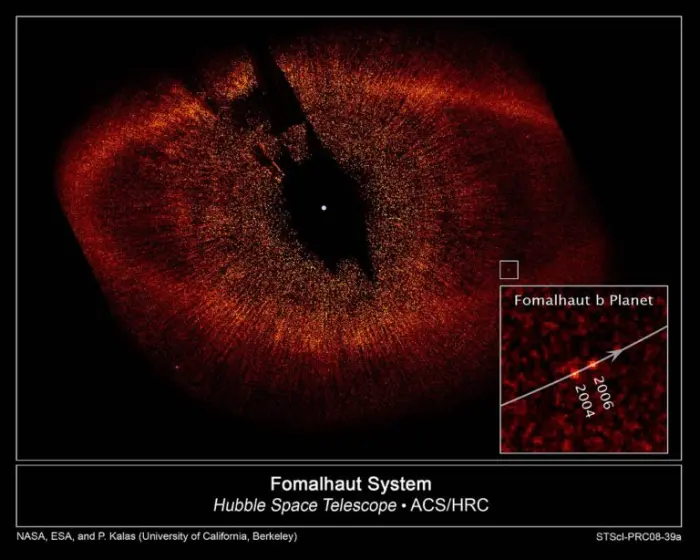
This image, taken with the Advanced Camera for Surveys aboard NASA’s Hubble Space Telescope, shows the newly discovered planet, Fomalhaut b, orbiting its parent star, Fomalhaut. The small white box at lower right pinpoints the planet’s location. Fomalhaut b has carved a path along the inner edge of a vast, dusty debris ring encircling Fomalhaut that is 21.5 billion miles across. Fomalhaut b lies 1.8 billion miles inside the ring’s inner edge and orbits 10.7 billion miles from its star. The inset at bottom right is a composite image showing the planet’s position during Hubble observations taken in 2004 and 2006. Astronomers have calculated that Fomalhaut b completes an orbit around its parent star every 872 years. The white dot in the center of the image marks the star’s location. The region around Fomalhaut’s location is black because astronomers used the Advanced Camera’s coronagraph to block out the star’s bright glare so that the dim planet could be seen. Fomalhaut b is 1 billion times fainter than its star. The radial streaks are scattered starlight. The red dot at lower left is a background star. Image: NASA, ESA, P. Kalas, J. Graham, E. Chiang, E. Kite (University of California, Berkeley), M. Clampin (NASA Goddard Space Flight Center), M. Fitzgerald (Lawrence Livermore National Laboratory), and K. Stapelfeldt and J. Krist (NASA Jet Propulsion Laboratory)
Fomalhaut is one of the 58 stars selected for use in navigation. Navigational stars have a special role in the field of celestial navigation because they are some of the brightest and most identifiable stars in the night sky. Fomalhaut’s neighbours Ankaa (Alpha Phoenicis), Diphda (Beta Ceti), and Alnair (Alpha Gruis) are also included on the list.
Fomalhaut is slightly fainter than Antares in the constellation Scorpius, Spica in Virgo and Pollux in Gemini, but outshines Deneb in Cygnus, Mimosa in Crux and Regulus in Leo.
Fomalhaut used to belong both to Piscis Austrinus and Aquarius. The Greco-Roman astronomer Ptolemy placed the star in both constellations in the 2nd century CE. The German uranographer Johann Bayer gave it the designation Alpha Piscis Austrini, placing it definitively in Piscis Austrinus as the constellation’s brightest star in his Uranometria (1603). The 17th century English astronomer John Flamsteed designated the star 24 Piscis Australis and assigned it the additional designation 79 Aquarii.
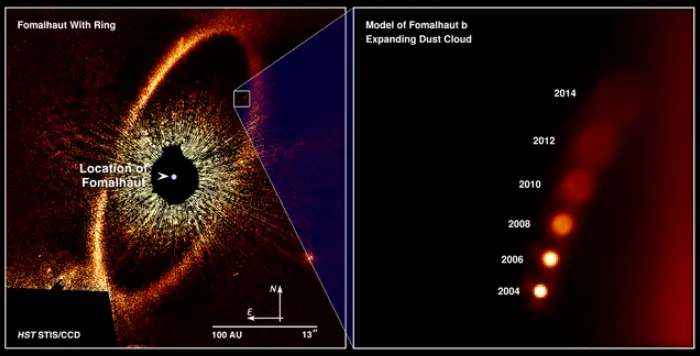
Compass image of the model of the Fomalhaut b dust cloud, credit: NASA, ESA, and A. Gáspár and G. Rieke (University of Arizona)
Fomalhaut was once considered to be a member of the Castor Moving Group, a stellar association that was believed to also include Castor and Vega. However, more recent studies have demonstrated that the stars have very different ages and velocities, and that they were not likely associated with one another millions of years ago.
Fomalhaut has served as a spectral standard for its class, A3 Va, since 1943. Its spectrum is one of the stable anchor points used to classify other stars.
Fomalhaut lies at a similar distance to Earth as Vega (another class A main sequence star), but it is a full magnitude fainter because it has a lower mass, smaller size, and lower surface temperature.
In medieval astrology, Fomalhaut was believed to bring success in science and writing, as well as in creative and artistic pursuits, if tied up with personal planets.
Like many other bright and nearby stars, Fomalhaut has been used in countless works of fiction. Notable uses and mentions include the novel Pebble in the Sky (1950) by Isaac Asimov, Gordon R. Dickson’s Dorsai! (1960), Stanislaw Lem’s Return from the Stars (1961), Jack Vance’s Star King (1964), Ursula K. Le Guin’s Rocannon’s World (1966), Philip K. Dick’s The Unteleported Man (1966), The Divine Invasion (1981) and Radio Free Albemuth (1985), The Zero Stone (1968) by Andre Norton, Joe Haldeman’s The Forever War (1974), Richard Avery’s The War Games of Zelos (1975), Frank Herbert’s Children of Dune (1976), Greg Egan’s Diaspora (1997), and Paul J. McAuley’s In the Mouth of the Whale (2012).
Name
The name Fomalhaut (pronunciation: /ˈfoʊməl.hɔːt/) comes from the Arabic phrase fam al-ḥūt (al-janūbī), meaning “the mouth of the whale,” referring to the mouth of the Southern Fish. The name was officially approved for Alpha Piscis Austrini A by the International Astronomical Union’s (IAU) Working Group on Star Names (WGSN) on December 15, 2015.
The star has been known by many other names across different cultures. The Latin names included Os Piscis Meridiani, Os Piscis Meridionalis and Os Piscis Notii.
The Persians called the star Hastorang in 2582 BCE and considered it one of the four “royal stars.” The royal stars of Persia – Fomalhaut in Piscis Austrinus, Aldebaran in Taurus, Regulus in Leo, and Antares in Scorpius – were regarded as the guardians of heaven.
Fomalhaut’s other Arabic name was Difda al Auwel, derived from aḍ-ḍifdiˤ al-’awwal, meaning “the first frog.” The second frog was the nearby Diphda, Beta Ceti.
The Chinese knew Fomalhaut as 北落師門/北落师门 (Běiluòshīmén), or North Gate of the Military Camp. The star was a sole member of the North Gate of the Military Camp asterism in the Encampment mansion, which corresponds to the constellations Piscis Austrinus, Andromeda, Aquarius, Capricornus, Cassiopeia, Cepheus, Cygnus, Lacerta, Pegasus, and Pisces.
The Moporr people of Victoria, Australia called the star Buunjill (the name referred to a masculine being), and the Wardaman people of the Northern Territory knew it as Menggen, meaning “white cockatoo.”
Location
Fomalhaut lies in the southern sky, but not as far south as Alpha Centauri, Canopus and Acrux. The star can be seen from most locations north of the equator. Its declination is similar to that of Antares. From the mid-northern latitudes, Fomalhaut appears above the horizon for at least 8 hours at certain times of the year, but never climbs very high in the sky.
The easiest way to identify Fomalhaut from northern locations is by using the Great Square of Pegasus, formed by the stars Alpheratz, Scheat, Markab and Algenib. The western side of the asterism points towards the mouth of the Southern Fish. A line drawn from Scheat through Markab across the sky leads to Fomalhaut. Even though Markab and Fomalhaut are separated by about 45 degrees, there are no other bright stars in the area between.

The location of Fomalhaut, image: Stellarium
The constellation Piscis Austrinus is mostly faint and surrounded by the faint Aquarius, Capricornus, Microscopium, and Sculptor. Fomalhaut does not have any exceptionally bright neighbours and appears quite isolated in the sky, which can make it challenging to identify the star despite its brightness.
Seen from southern latitudes, Fomalhaut lies along an imaginary line drawn from Canopus, the second brightest star in the sky, through Achernar, the 9th brightest star. Fomalhaut forms a roughly equilateral triangle with the brighter Achernar in the constellation Eridanus and fainter Peacock in Pavo, and a smaller triangle with the fainter Alnair in Grus and Ankaa in Phoenix.
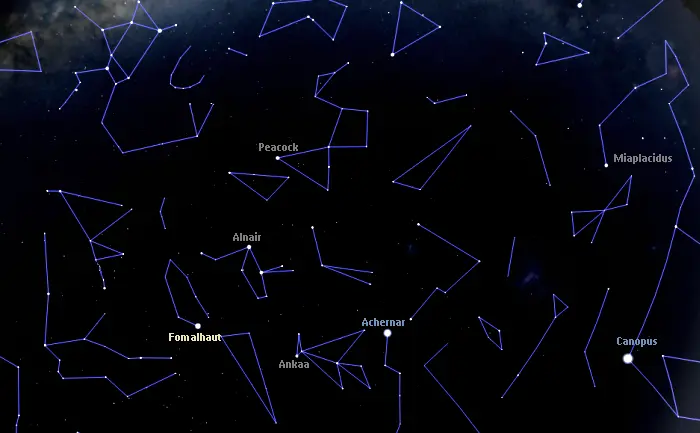
Fomalhaut from the southern hemisphere, image: Stellarium
Fomalhaut lies in the same region of the sky as several notable deep sky objects. The best known of these, the Helix Nebula (NGC 7293), is a bright (mag. 7.6) planetary nebula located in the constellation Aquarius. Like Fomalhaut, the nebula has also been nicknamed the “Eye of Sauron,” but is probably better known as the “Eye of God.” The Helix Nebula lies about 10 degrees northwest of the star.
The Whale Galaxy (NGC 55), a bright (mag. 7.87) Magellanic-type barred spiral galaxy, lies in the opposite direction. The galaxy is located in the constellation Sculptor and should not be confused with the other Whale Galaxy (NGC 4631), located in Canes Venatici.
The Sculptor Galaxy (NGC 253), a starburst spiral galaxy also known as the Silver Coin Galaxy, is located northeast of Fomalhaut, in the constellation Sculptor, near the border with Cetus.
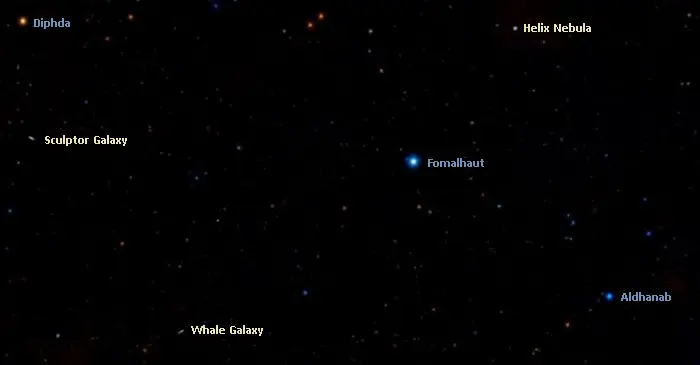
Fomalhaut, the Helix Nebula, the Sculptor Galaxy and the Whale Galaxy, image: Wikisky
Constellation
Fomalhaut is the luminary of Piscis Austrinus (the Southern Fish), a small constellation in the southern sky that does not contain any other stars brighter than magnitude 4.00. The star marks the mouth of the fish.
Piscis Austrinus occupies an area of 245 square degrees and is the 60th largest of the 88 constellations. It is one of the 48 Greek constellations, catalogued by Claudius Ptolemy of Alexandria in his Almagest in the 2nd century CE.
Once also known as Piscis Notius, Piscis Austrinus represents the Southern Fish, or the Great Fish in Greek mythology. It is usually depicted as swallowing the water poured by the neighbouring Aquarius, the Water Bearer. Fomalhaut is located on the constellation’s western border.
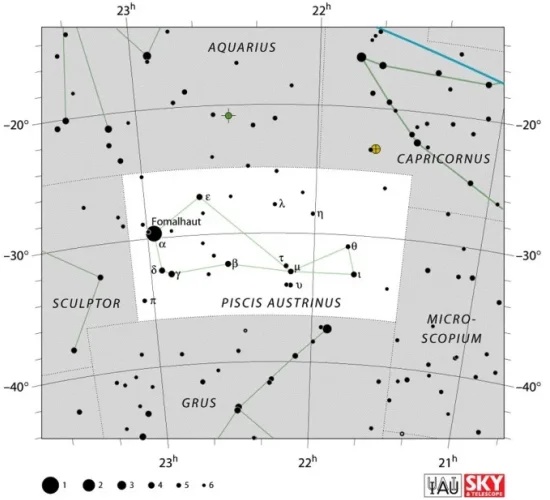
Piscis Austrinus constellation map by IAU and Sky&Telescope magazine
Piscis Austrinus does not contain many bright deep sky objects. It is home to several relatively bright galaxies – NGC 7172, NGC 7174, NGC 7314, and NGC 7259 – the last of which hosted a supernova observed in 2009 and designated SN 2009ip.
The best time of the year to observe Fomalhaut and other stars of Piscis Austrinus is during the month of October, when the constellation appears higher above the horizon in the evening sky. The entire constellation is visible from locations south of the latitude 55° N.
The 10 brightest stars in Piscis Austrinus are Fomalhaut (Alpha PsA, mag. 1.16), Epsilon Piscis Austrini (mag. 4.17), Delta Piscis Austrini (mag. 4.175), Beta Piscis Austrini (mag. 4.29), Iota Piscis Austrini (mag. 4.35), Gamma Piscis Austrini (mag. 4.448), Mu Piscis Austrini (mag. 4.49), Tau Piscis Austrini (mag. 4.945), Upsilon Piscis Austrini (mag. 4.98), and Theta Piscis Austrini (mag. 5.01).
Alpha Piscis Austrini
| Spectral class | A3 V / K5Vp / M4V |
| Constellation | Piscis Austrinus (Fomalhaut A and B), Aquarius (Fomalhaut C) |
| Designations | Fomalhaut, Alpha Piscis Austrini, α PsA, 24 Piscis Austrini |
Fomalhaut – Alpha Piscis Austrini A
| Spectral class | A3 V |
| U-B colour index | 0.08 |
| B-V colour index | 0.09 |
| Apparent magnitude | 1.16 |
| Absolute magnitude | 1.72 |
| Angular size | 0.212 arcminutes |
| Distance | 25.13 ± 0.09 light-years (7.70 ± 0.03 parsecs) |
| Parallax | 129.81 ± 0.47 mas |
| Radial velocity | +6.5 ± 0.5 km/s |
| Proper motion | RA: +328.95 ± 0.50 mas/yr |
| Dec.: -164.67 ± 0.35 mas/yr | |
| Mass | 1.92 ± 0.02 M☉ |
| Luminosity | 16.63 ± 0.48 L☉ |
| Radius | 1.842 ± 0.019 R☉ |
| Temperature | 8,590 K |
| Metallicity | -0.03 to -0.34 dex |
| Age | 440 ± 40 million years |
| Rotational velocity | 93 km/s |
| Surface gravity | 4.21 cgs |
| Constellation | Piscis Austrinus |
| Right ascension | 22h 57m 39.0465s |
| Declination | -29° 37′ 20.050” |
| Designations | Fomalhaut, Alpha Piscis Austrini, α PsA, 24 Piscis Austrini, HD 216956, HR 8728, HIP 113368, GC 32000, SAO 191524, GCRV 14409, LTT 9292, FK5 867, CPD −30° 6685, CD-30 19370, GJ 881, IRAS 22549-2953, 2MASS J22573901-2937193, PPM 274426, TYC 6977-1267-1 |
Fomalhaut B – TW Piscis Austrini
| Spectral class | K5Vp |
| Variable type | BY Draconis |
| U-B colour index | 1.02 |
| B-V colour index | 1.10 |
| Apparent magnitude | 6.48 |
| Absolute magnitude | 7.08 |
| Distance | 24.793 ± 0.005 light-years (7.602 ± 0.002 parsecs) |
| Parallax | 131.5525 ± 0.0275 mas |
| Radial velocity | +7.153 ± 0.0003 km/s |
| Proper motion | RA: 330.203 ± 0.023 mas/yr |
| Dec.: -158.602 ± 0.028 mas/yr | |
| Mass | 0.725 ± 0.036 M☉ |
| Luminosity | 0.19 L☉ |
| Radius | 0.629 ± 0.051 R☉ |
| Temperature | 4,711 ± 134 K |
| Age | 440 million years |
| Rotational velocity | 2.93 km/s |
| Constellation | Piscis Austrinus |
| Right ascension | 22h 56m 24.05327s |
| Declination | -31° 33′ 56.0351” |
| Designations | Fomalhaut B, Alpha Piscis Austrini B, TW Piscis Austrini, TW PsA, HD 216803, HR 8721, HIP 113283, SAO 214197, LTT 9283, GCTP 5562.00, GJ 879, CD -32°17321, CP(D)-32 6550, GC 31978, GCRV 14398, IRAS 22536-3150, 2MASS J22562403-3133559, PPM 303193, TYC 7505-100-1, Gaia DR2 6604147121141267712, Gaia DR3 6604147121141267712 |
Fomalhaut C – LP 876-10
| Spectral class | M4V |
| Apparent magnitude | 12.624 |
| Absolute magnitude | 13.21 ± 0.02 |
| Angular size | 0.0083 arcminutes |
| Distance | 25.037 ± 0.006 light-years (7.676 ± 0.002 parsecs) |
| Parallax | 130.2707 ± 0.0325 mas |
| Radial velocity | 5.77 ± 0.58 km/s |
| Proper motion | RA: 331.609 ± 0.031 mas/yr |
| Dec.: -183.805 ± 0.031 mas/yr | |
| Mass | 0.18 ± 0.02 M☉ |
| Luminosity | 0.004603 L☉ |
| Radius | 3,132 ± 65 R☉ |
| Metallicity | -0.1 dex |
| Constellation | Aquarius |
| Right ascension | 22h 48m 04.4928501697s |
| Declination | -24° 22′ 07.717793375” |
| Designations | Fomalhaut C, Alpha Piscis Austrini C, LP 876-10, NLTT 54872, GSC 06964-01226, 2MASS J22480446-2422075, WDS J22577-2937C, Gaia DR2 6623351805412369024, Gaia DR3 6623351805412369024 |